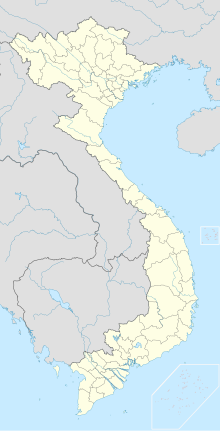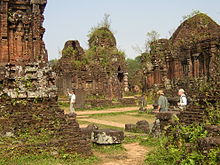Mỹ Sơn
| Sanctuary Mỹ Sơn | |
|---|---|
|
UNESCO world heritage |
|

|
|
| National territory: |
|
| Type: | Culture |
| Criteria : | ii, iii |
| Reference No .: | 949 |
| UNESCO region : | Asia and Pacific |
| History of enrollment | |
| Enrollment: | 1999 (session 23) |
Coordinates: 15 ° 46 ′ 0 ″ N , 108 ° 7 ′ 0 ″ E
My Son ( Vietnamese : Mỹ Sơn "beautiful mountain", from Chinese美 山) is a temple city in central Vietnam . In 1999 it was declared a World Heritage Site.
geography
My Son is located in the province of Quảng Nam , about 25 kilometers west-southwest of the former port city of Hội An .
history
From the 2nd or 3rd century the Cham culture emerged on the coast of Vietnam . Culturally, this was strongly influenced by Indian culture, which was expressed in particular in the adoption of Hindu beliefs (worship of the god Shiva ) and in art.
From Champa, the kingdom of the Cham, more than 70 temples have been preserved in My Son, which usually consist of a central tower-like structure and smaller surrounding buildings.
Excavations began in 2002 as part of a project funded with $ 70,000 by UNESCO .
The most famous tower was 24 meters high and decorated with sculptures of lions and elephants. It was destroyed in 1969 when the area was bombed by US planes during the Vietnam War. During these bombardments, a total of 50 of the 70 or so temples previously recorded by the archaeologists of the École française d'Extrême-Orient in the first half of the 20th century were badly damaged or destroyed. Reconstruction work - supported by international experts - turns out to be extremely difficult, since the seamless construction of the Cham has not yet been reproducible and the use of mortar leads to unsightly moss growth.
Outline of the plant
After the collapse of the Champa empire, the complex was forgotten and was rediscovered by the French colonial rulers at the end of the 19th century. The École française d'Extrême-Orient (EFEO) has thoroughly examined the facility and partially restored it. In this context, Henri Parmentier recorded the entire system. He found the remains of a total of 71 temples. He divided these temples into 14 groups, assigning letters to the groups and consecutive numbers to the individual temples of the groups. The adjacent illustration shows the location of the temples according to this system.
World Heritage
My Son was included in the World Heritage List because the temple town of My Son symbolizes cultural exchange and the influence of Hindu architecture on Southeast Asia. In addition, Champa was an important part of the political and cultural history of Southeast Asia, which is illustrated by the My Sons ruins.
photos
Others
Not far from Mỹ Sơn is the first capital of the Champas, Trà Kiệu . Almost nothing is left of this city.
Web links
- Kazuo Iwase: My Son: Champa Ruins in Vietnam. Extensive photo documentation. Text in English and Japanese











